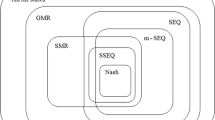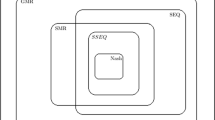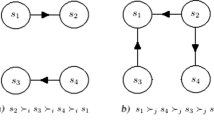Abstract
Conflicts occur when multiple parties interact and have different evaluations about the possible scenarios that may occur. There are conflicts not only in daily events as in parents deciding which school to choose for their kids, but also among countries deciding how to reduce global warming. The graph model for conflict resolution (GMCR) is an efficient model to represent and analyze conflicts. The GMCR models the conflict considering sequences of moves and countermoves that can be made by the decision makers (DMs) in the course of a conflict. Since DMs may present different behavior in conflicts there are several stability concepts that have been proposed in the GMCR. Matrix representations have been developed for many of these stability concepts in order to provide a more computationally tractable method to find stable states in a conflict. Berge stabilities were recently introduced into the GMCR to analyze the effects of altruistic behavior in the stability analysis of conflicts. In particular, Berge behavior occurs in disputes where DMs act benevolently anticipating a similar response from others such that, in the end, their actions are in their own self-interest. As it happens with other solution GMCR concepts, the logical definitions of Berge stabilities are hard to apply in large conflicts with a high number of states or DMs. In this work, our objective is to propose matrix representations for Berge stabilities so that it becomes computationally tractable to analyze the effect of altruistic behavior in large conflicts. To illustrate the applicability of the proposed matrix representations, we apply the method to the Elmira conflict.
Similar content being viewed by others
References
Abalo, K., & Kostreva, M. (2004). Some existence theorems of Nash and Berge equilibria. Applied Mathematics Letters, 17(5), 569–573.
Berge, C. (1957). Théorie générale des jeux á n personnes. No. 138 in Mémorial des sciences mathématiques, Gauthier-Villars, Paris
Colman, A. M., Korner, T. W., Musy, O., & Tazdat, T. (2011). Mutual support in games: Some properties of Berge equilibria. Journal of Mathematical Psychology, 55(2), 166–175.
Corley, H. W., & Kwain, P. (2015). An algorithm for computing all Berge equilibria. Game Theory. https://doi.org/10.1155/2015/862842
Courtois, P., Nessah, R., & Tazdat, T. (2015). How to play games? Nash versus Berge behaviour rules. Economics and Philosophy, 31(1), 123–139.
Dowlatabadi, N., Banihabib, M. E., Roozbahani, A., & Randhir, T. O. (2020). Enhanced GMCR model for resolving conflicts in a transboundary wetland. Science of the Total Environment, 744, 140816. https://doi.org/10.1016/j.scitotenv.2020.140816
Fang, L., Hipel, K. W., & Kilgour, D. M. (1993). Interactive decision making. Wiley.
Fraser, N. M., & Hipel, K. W. (1979). Solving complex conflicts. IEEE Transactions on Systems, Man, and Cybernetics, 9(12), 805–817.
Hipel, K. W., & Fang, L. (2021). The graph model for conflict resolution and decision support. IEEE Transactions on Systems, Man, and Cybernetics: Systems, 51(1), 131–141.
Hipel, K. W., Fang, L., & Kilgour, D. M. (2020). The graph model for conflict resolution: Reflections on three decades of development. Group Decision and Negotiation, 29, 11–60.
Hipel, K. W., Fang, L., Kilgour, D. M., & Haight, M. (1993). Environmental conflict resolution using the graph model. Proceedings of IEEE Systems Man and Cybernetics Conference, 1, 153–158. https://doi.org/10.1109/ICSMC.1993.384737
Howard, N. (1971). Paradoxes of rationality. MIT Press.
Kilgour, D. M. (1985). Anticipation and stability in two-person noncooperative games. In U. Luterbacher & M. D. Ward (Eds.), Dynamic models of international conflict (pp. 26–51). Boulder: Lynne Rienner Press.
Kilgour, D. M., Hipel, K. W., & Fang, L. (1987). The graph model for conflicts. Automatica, 23(1), 41–55.
Kinsara, R. A., Kilgour, D. M., & Hipel, K. W. (2015). Inverse approach to the graph model for conflict resolution. IEEE Transactions on Systems, Man, and Cybernetics: Systems, 45(5), 734–742. https://doi.org/10.1109/TSMC.2014.2376473
Larbani, M., & Nessah, R. (2008). A note on the existence of Berge and Berge–Nash equilibria. Mathematical Social Sciences, 55(2), 258–271.
Larbani, M., & Zhukovskii, V. I. (2017). Berge equilibrium in normal form static games: A literature review. Izv Inst Mat Inform Udmurt Gos Univ, 49, 80–110.
Mérő, L. (1998). The prisoner’s dilemma. Moral calculations: Game theory, logic, and human frailty, pp 28–47
Nash, J. F. (1950). Equilibrium points in n-person games. National Academy of Sciences, 36(1), 48–49.
Naude, B., Prinsloo, J., & Ladikos, A. (2003). Restorative mediation practices. Southern African Journal of Criminology, 16(5), 10–22.
Philpot, S. L., Johnson, P. A., & Hipel, K. W. (2017). Analysis of a brownfield management conflict in Canada. Hydrological Research Letters, 11(3), 141–148.
Rêgo, L. C., & de Oliveira, F. E. (2020). Higher-order sequential stabilities in the graph model for conflict resolution for bilateral conflicts. Group Decision and Negotiation, 29, 601–626.
Rêgo, L., & Vieira, G. (2015). Matrix representation of solution concepts in the graph model for conflict resolution with probabilistic preferences. In: The 15th international conference on group decision and negotiation letters, vol 1, pp 239–244
Rêgo, L. C., & Vieira, G. I. A. (2017). Symmetric sequential stability in the graph model for conflict resolution with multiple decision makers. Group Decision and Negotiation, 26, 775–792.
Rêgo, L. C., & Vieira, G. I. A. (2019). Maximin\(_h\) stability in the graph model for conflict resolution for bilateral conflicts. IEEE Transactions on Systems, Man, and Cybernetics: Systems, 50(10), 3760–3769.
Rêgo, L. C., & Vieira, G. I. A. (2021). Matrix representation of solution concepts in the graph model for conflict resolution with probabilistic preferences and multiple decision makers. Group Decision and Negotiation. https://doi.org/10.1007/s10726-021-09729-y
Rêgo, L. C., Vieira, G. I. A., & Kilgour, D. M. (2023). The graph model for conflict resolution and credible maximin stability. IEEE Transactions on Systems, Man, and Cybernetics: Systems, 53(2), 947–956.
Roberts, F. S. (2008). Computer science and decision theory. Annals of Operations Research, 163, 209–253. https://doi.org/10.1007/s10479-008-0328-z
Sabino, E. R., & Rêgo, L. C. (2023). Optimism pessimism stability in the graph model for conflict resolution for multilateral conflicts. European Journal of Operational Research. https://doi.org/10.1016/j.ejor.2023.01.038
Vieira, G. I. A., & Rêgo, L. C. (2020). Berge solution concepts in the graph model for conflict resolution. Group Decision and Negotiation, 29, 103–125.
Wang, D., Huang, J., & Xu, Y. (2022). Matrix representation of stability definitions in the graph model for conflict resolution with grey-based preferences. Discrete Applied Mathematics, 320, 106–125.
Warrier, U., Shankar, A., & Belal, H. M. (2021). Examining the role of emotional intelligence as a moderator for virtual communication and decision making effectiveness during the COVID-19 crisis: revisiting task technology fit theory. Annals of Operations Research. https://doi.org/10.1007/s10479-021-04216-8
Wu, N., Kilgour, D. M., Hipel, K. W., & Xu, Y. (2021). Matrix representation of stability definitions for the graph model for conflict resolution with reciprocal preference relations. Fuzzy Sets and Systems, 409, 32–54. https://doi.org/10.1016/j.fss.2020.03.002
Xu, H., Hipel, K., & Kilgour, D. (2007). Matrix representation of conflicts with two decision-makers. Proceedings of IEEE International Conference on Systems, Man and Cybernetics, 1, 1764–1769.
Xu, H., Hipel, K., & Kilgour, D. (2009). Matrix representation of solution concepts in multiple-decision-maker graph models. Proceedings of IEEE International Conference on Systems, Man and Cybernetics—Part: A: Systems and Humans, 39(1), 96–108.
Xu, H., Hipel, K. W., & Kilgour, D. M. (2009). Matrix representation of solution concepts in multiple-decision-maker graph models. IEEE Transactions on Systems, Man, and Cybernetics - Part A: Systems and Humans, 39(1), 96–108. https://doi.org/10.1109/TSMCA.2009.2007994
Xu, H., Kilgour, D.M., Hipel, K.W. (2009c). An algebraic approach to calculating stabilities in the graph model with strength of preference. In: 2009 IEEE international conference on systems, man and cybernetics (pp. 1539–1544). https://doi.org/10.1109/ICSMC.2009.5346310
Xu, H., Li, K. W., Hipel, K. W., & Kilgour, D. M. (2009). A matrix approach to status quo analysis in the graph model for conflict resolution. Applied Mathematics and Computation, 212(2), 470–480. https://doi.org/10.1016/j.amc.2009.02.051
Xu, H., Kilgour, D. M., & Hipel, K. W. (2010). An integrated algebraic approach to conflict resolution with three-level preference. Applied Mathematics and Computation, 216(3), 693–707. https://doi.org/10.1016/j.amc.2010.01.054
Xu, H., Kilgour, D. M., Hipel, K. W., & Kemkes, G. (2010). Using matrices to link conflict evolution and resolution in a graph model. European Journal of Operational Research, 207(1), 318–329. https://doi.org/10.1016/j.ejor.2010.03.025
Xu, H., Kilgour, D. M., & Hipel, K. W. (2011). Matrix representation of conflict resolution in multiple-decision-maker graph models with preference uncertainty. Group Decision and Negotiation, 20(6), 755–779. https://doi.org/10.1007/s10726-010-9188-4
Xu, H., Li, N., Han, X., Zhang, P. (2011b). An algebraic approach to conflict resolution with hybrid preference in two decision maker graph models. In: 2011 IEEE international conference on systems, man, and cybernetics (pp. 2725–2730). https://doi.org/10.1109/ICSMC.2011.6084085
Xu, H., Hipel, K. W., Kilgour, D. M., & Fang, L. (2018). Conflict resolution using the graph model: Strategic interactions in competition and cooperation (Vol. 153). Department of Systems Design Engineering, University of Waterloo.
Xu, H., Zhao, J., Ke, G. Y., & Ali, S. (2019). Matrix representation of consensus and dissent stabilities in the graph model for conflict resolution. Discrete Applied Mathematics, 259, 205–217. https://doi.org/10.1016/j.dam.2018.12.006
Zhu, Z., Kilgour, D. M., & Hipel, K. W. (2020). A new approach to coalition analysis within the graph model. IEEE Transactions on Systems, Man, and Cybernetics: Systems, 50(6), 2231–2241. https://doi.org/10.1109/TSMC.2018.2811402
Zhukovskii, V. I. (1985). Some problems of nonantagonistic differential games. In P. Kenderov (Ed.), Matematiceskie Metody (pp. 103–195).
Author information
Authors and Affiliations
Corresponding author
Ethics declarations
Conflict of interest
The authors acknowledge funding from the Conselho Nacional de Desenvolvimento Científico e Tecnológico (CNPQ), under grants 428325/2018-1 and 308980/2021-2, and the Coordenação de Aperfeiçoamento de Pessoal de Nível Superior (CAPES), financing code 001.
Additional information
Publisher's Note
Springer Nature remains neutral with regard to jurisdictional claims in published maps and institutional affiliations.
Appendices
Computational codes





Matrices for the Elmira conflict
We now show the matrices that are inputs for the Berge stabilities calculations in the Elmira conflict for DM UR. First, the accessibility and strict preference matrices for DM UR are given by:
Then, the matrices that represent the legal sequence of unilateral moves and unilateral improvements for the coalition formed by the opponents of DM UR are given by:
Finally, we display matrices \(M_{UR}^{Berge}\), \(M_{UR}^{WB}\), \(M_{UR}^{SMB}\), \(M_{UR}^{SMB}\), \(M_{UR}^{WMB}\), \(M_{UR}^{WSMB}\), whose elements of the main diagonal are equal to zero if and only if the corresponding state satisfies the appropriate Berge stability for DM UR.
Rights and permissions
Springer Nature or its licensor (e.g. a society or other partner) holds exclusive rights to this article under a publishing agreement with the author(s) or other rightsholder(s); author self-archiving of the accepted manuscript version of this article is solely governed by the terms of such publishing agreement and applicable law.
About this article
Cite this article
Rêgo, L.C., Cordeiro, Y.S. Matrix representations of berge stabilities in the graph model for conflict resolution. Ann Oper Res 332, 125–148 (2024). https://doi.org/10.1007/s10479-023-05555-4
Received:
Accepted:
Published:
Issue Date:
DOI: https://doi.org/10.1007/s10479-023-05555-4






